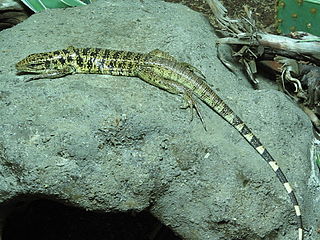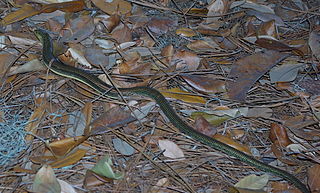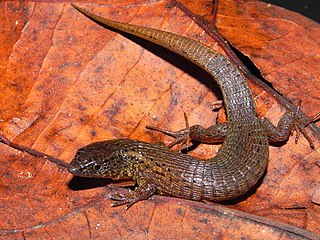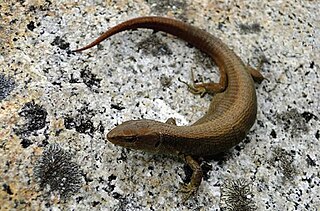
Eremiascincus is a genus of skinks, lizards in the family Scincidae. The genus is endemic to Australia, Indonesia, and East Timor.

The genus Sphenomorphus – vernacularly also known as the common skinks – currently serves as a "wastebin taxon" for numerous skinks. While most or all species presently placed here are probably rather close relatives, the genus as presently delimited is likely to be not monophyletic and is in need of review. Some species in this genus have been moved to Pinoyscincus.

Cnemidophorus is a genus of lizards in the family Teiidae. Species in the genus Cnemidophorus are commonly referred to as whiptail lizards or racerunners. The genus is endemic to South America, Central America, and the West Indies.

Kentropyx is a genus of whiptail lizards in the family Teiidae. The genus is endemic to South America including Trinidad and Barbados.

Tupinambis is a lizard genus which belongs to the family Teiidae and contains eight described species. These large lizards are commonly referred to as tegus. T. merianae, T. rufescens, and T. teguixin are popular in the pet trade. They are primarily found in South America, although T. teguixin also occurs in Panama.

Ophisaurus is a genus of superficially snake-like legless lizards in the subfamily Anguinae. Known as joint snakes, glass snakes, or glass lizards, they are so-named because their tails are easily broken; like many lizards, they have the ability to deter predation by dropping off part of the tail, which can break into several pieces, like glass. The tail remains mobile, distracting the predator, while the lizard becomes motionless, allowing eventual escape. This serious loss of body mass requires a considerable effort to replace, and can take years to do so. Despite this ability, the new tail is usually smaller than the original.

Alopoglossus is a genus of lizards in the monogeneric family Alopoglossidae. The genus is distributed from Costa Rica in Central America to northern South America.

Anadia is a genus of lizards in the family Gymnophthalmidae. The genus is endemic to southern Central America and northern South America.
Ecpleopus is a genus of lizard in the family Gymnophthalmidae. The genus contains only one species, Ecpleopus gaudichaudii, which is endemic to Brazil.

Euspondylus is a genus of lizards in the family Gymnophthalmidae.

Gymnophthalmus is genus of lizards in the family Gymnophthalmidae. The genus is native to Mexico, Central America, and the northern part of South America. Eight species are recognized as being valid.

Neusticurus is a genus of gymnophthalmid lizards endemic to northern South America. They are often found near streams and are semi-aquatic. Some species formerly included in this genus are now placed in Potamites, which also are semi-aquatic inhabitants of South America.

George Albert Boulenger was a Belgian-British zoologist who described and gave scientific names to over 2,000 new animal species, chiefly fish, reptiles, and amphibians. Boulenger was also an active botanist during the last 30 years of his life, especially in the study of roses.
Ophiomorus tridactylus, commonly known as the three-toed snake skink, is a species of skink endemic to sandy desert areas of South Asia. It is also called the Indian sand-swimmer for its habit of moving just under the sand.

Dendrelaphis is a genus of colubrid snakes, distributed from Pakistan, India and southern China to Indonesia, Timor-Leste, the Philippines, Australia, New Guinea and the Solomon Islands. There are over forty described species. Asian species are known commonly as bronzebacks, while the Australo-Papuan species are simply called treesnakes. All are non-venomous and entirely harmless to humans.
Theodorus Willem van Lidth de Jeude was a Dutch zoologist and herpetologist. He is not to be confused with his grandfather's brother, the Dutch veterinarian and zoologist Theodoor Gerard van Lidth de Jeude (1788–1863).

Dopasia is a genus of lizards in the family Anguidae. The genus contains seven species, which are native to Asia. They are most closely related to the North American Ophisaurus, and are sometimes considered part of that genus.
Arthrosaura tyleri is a species of lizard in the family Gymnophthalmidae. The species is endemic to Venezuela.
Arthrosaura versteegii is a species of lizard in the family Gymnophthalmidae. The species is indigenous to northeastern South America.
Neusticurus tatei, also known commonly as Tate's neusticurus, is a species of lizard in the family Gymnophthalmidae. The species is endemic to Venezuela.













